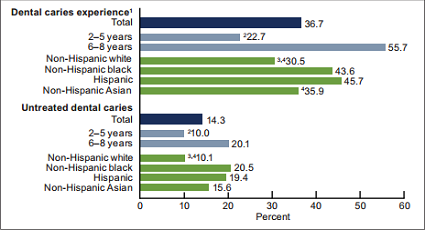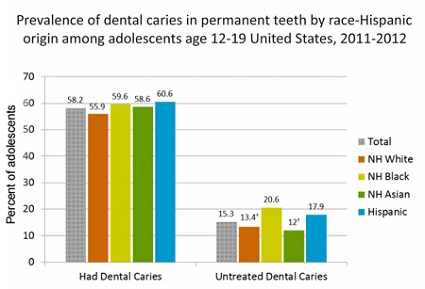According to a report released last Thursday by the U.S. Centers for Disease Control & Prevention, cavities in preschoolers appear to be declining and fewer young children have untreated dental decay – here in the United States.
Children’s tooth decay is still a major problem, both here in the States and around the world.

Source: CDC/NCHS National Health & Nutrition Survey, 2011-12
As quoted in this NY Times article, Dr. Bruce Dye, the lead author of the past two C.D.C. reports on oral health, said that “only 10 percent of preschooler kids have untreated tooth decay.”
How Prevalent Is Children’s Tooth Decay?
This is considered to be the first drop in children’s dental decay for this age group since 2007, when a report from the CDC cited an alarming rise in decayed baby teeth.
Dr. Bruce Dye, the lead author of the past two CDC reports on oral health, said that “only 10 percent of preschooler kids have untreated tooth decay.
“This is the lowest percentage we have seen in the past 25 years,” he added.
Though the results cover just two years of data and may not be “statistically significant,” they suggest some promising broad-stroke trends, Dr. Dye said.
The 2007 report, which shocked dentists and led to policy changes, used five years of data. The numbers come from the National Health and Nutrition Examination Survey, a robust sample of national trends.
Will Kids Untreated Tooth Decay Just Get Better?
The following are key findings from the most recent CDC report:
– Approximately 23% of children ages 2 to 5 years had caries in primary teeth.
– Caries among children ages 6 to 8 was 56%.
– Untreated caries in primary teeth among children ages 2 to 8 years was twice as high for Hispanic and black children compared with white children.
– Among those ages 6 to 11, 27% of Hispanic youth had caries in permanent teeth, compared with nearly 18% of white and Asian youth.
– About 3 in 5 adolescents ages 12 to 19 had caries in permanent teeth, and 15% of these adolescents had untreated caries.
– For children ages 6 to 11, dental sealants were more prevalent for white children (44%) compared with black and Asian children (31% each).
What Does The ADA Say About This Drop In Untreated Kids Tooth Decay?
In reaction to the CDC report, the American Dental Association indicated that the latest statistics are just preliminary, and more needs to be proven before jumping to any broad-based conclusions.
However, one positive aspect that can be extrapolated from the most recent report is that it appears more kids are receiving treatment when dental disease (tooth decay, cavities) does occur.
“[The data] reflects only the first two years of what will be a longer and more comprehensive survey, and we look forward to seeing a final report,” the ADA said in their press release.
“But even if the full study confirms a positive trend, the fact that dental decay still afflicts so many U.S. children is simply unacceptable.”
Prevention Saves Money & Leads to Better Grades
Did you know pediatric dental disease is 5 times more common than asthma and 7 times more common than hay fever?
Prevention is crucial to limiting the damage done to children’s health as a result of untreated dental disease.
It’s up to parents to work with their kids, teaching them what is required to brush their teeth well and to use dental floss every day.

Source: CDC
According to the Academy of General Dentistry, more than 51 million school hours are lost each year due to dental-related illnesses.
Despite these numbers, many children still do not visit the dentist…and as a result, tooth decay remains untreated.
The Prevention Prescription to Kid’s Tooth Decay
Brushing 2x for 2 minutes a day, flossing, seeing the dentist regularly comprise the formula of the recommended prescription for preventing children’s tooth decay – or allowing it to go untreated.
– brushing for 2mins, 2x per day
– using dental floss
– regular dental checkups
– dental sealants
– a diligent daily dental hygiene routine
Dental caries, the dental health name for tooth decay, has become more common among young children over the past 15 years or so.
In 1988, caries was found in roughly 1 in 4 preschool-aged children. But by 2004, that rate swelled to 28 percent.
The incidence rate is even more severe when including toddlers. The CDC found that 37 percent of children ages 2 to 8 had experienced dental caries in their primary teeth between 2011 and 2012.
In an age where we have mobile apps that time & track our brushing habits, enjoy exotic cupcake & bacon flavors of dental floss to name just two, and see lots of opportunities to get dental decay in children treated at a low-cost or even free, it is plainly irresponsible for any parent to let these numbers creep back up into the epidemic ballpark.
Children’s tooth decay is 100% preventable!


